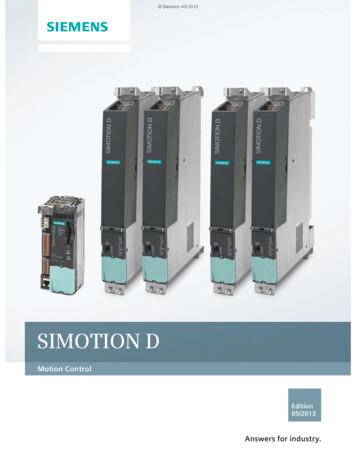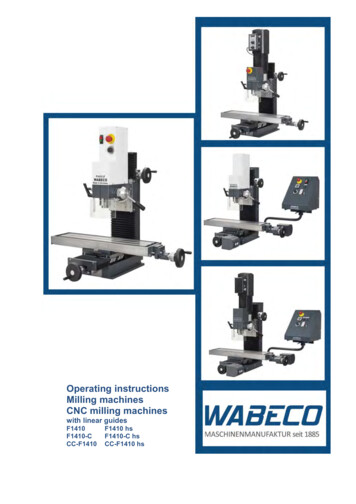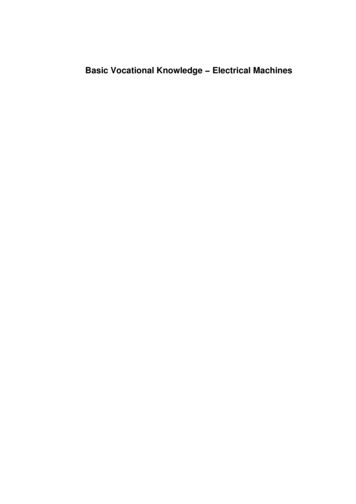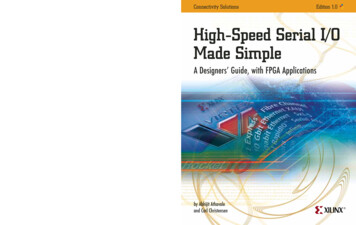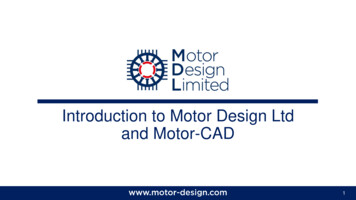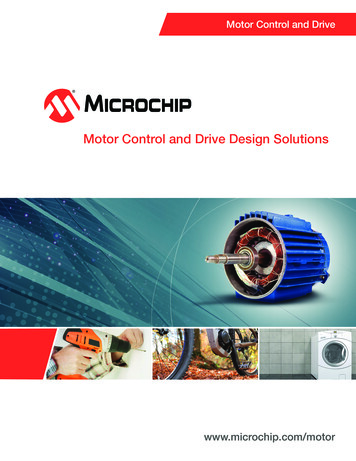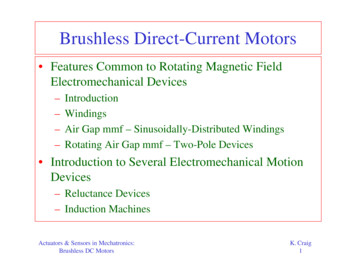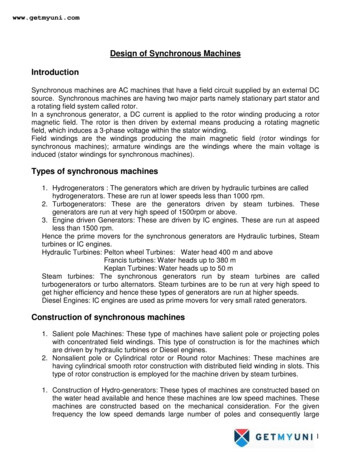
Transcription
www.getmyuni.comDesign of Synchronous MachinesIntroductionSynchronous machines are AC machines that have a field circuit supplied by an external DCsource. Synchronous machines are having two major parts namely stationary part stator anda rotating field system called rotor.In a synchronous generator, a DC current is applied to the rotor winding producing a rotormagnetic field. The rotor is then driven by external means producing a rotating magneticfield, which induces a 3-phase voltage within the stator winding.Field windings are the windings producing the main magnetic field (rotor windings forsynchronous machines); armature windings are the windings where the main voltage isinduced (stator windings for synchronous machines).Types of synchronous machines1. Hydrogenerators : The generators which are driven by hydraulic turbines are calledhydrogenerators. These are run at lower speeds less than 1000 rpm.2. Turbogenerators: These are the generators driven by steam turbines. Thesegenerators are run at very high speed of 1500rpm or above.3. Engine driven Generators: These are driven by IC engines. These are run at aspeedless than 1500 rpm.Hence the prime movers for the synchronous generators are Hydraulic turbines, Steamturbines or IC engines.Hydraulic Turbines: Pelton wheel Turbines: Water head 400 m and aboveFrancis turbines: Water heads up to 380 mKeplan Turbines: Water heads up to 50 mSteam turbines: The synchronous generators run by steam turbines are calledturbogenerators or turbo alternators. Steam turbines are to be run at very high speed toget higher efficiency and hence these types of generators are run at higher speeds.Diesel Engines: IC engines are used as prime movers for very small rated generators.Construction of synchronous machines1. Salient pole Machines: These type of machines have salient pole or projecting poleswith concentrated field windings. This type of construction is for the machines whichare driven by hydraulic turbines or Diesel engines.2. Nonsalient pole or Cylindrical rotor or Round rotor Machines: These machines arehaving cylindrical smooth rotor construction with distributed field winding in slots. Thistype of rotor construction is employed for the machine driven by steam turbines.1. Construction of Hydro-generators: These types of machines are constructed based onthe water head available and hence these machines are low speed machines. Thesemachines are constructed based on the mechanical consideration. For the givenfrequency the low speed demands large number of poles and consequently large1
www.getmyuni.comdiameter. The machine should be so connected such that it permits the machine to betransported to the site. It is a normal to practice to design the rotor to withstand thecentrifugal force and stress produced at twice the normal operating speed.Stator core:The stator is the outer stationary part of the machine, which consists of The outer cylindrical frame called yoke, which is made either of welded sheet steel,cast iron.The magnetic path, which comprises a set of slotted steel laminations called statorcore pressed into the cylindrical space inside the outer frame. The magnetic path islaminated to reduce eddy currents, reducing losses and heating. CRGO laminations of0.5 mm thickness are used to reduce the iron losses.A set of insulated electrical windings are placed inside the slots of the laminated stator.The cross-sectional area of these windings must be large enough for the power rating ofthe machine. For a 3-phase generator, 3 sets of windings are required, one for eachphase connected in star. Fig. 1 shows one stator lamination of a synchronous generator.In case of generators where the diameter is too large stator lamination can not bepunched in on circular piece. In such cases the laminations are punched in segments. Anumber of segments are assembled together to form one circular laminations. All thelaminations are insulated from each other by a thin layer of varnish.Details of construction of stator are shown in Figs 2 -Fig. 1. Stator lamination2
www.getmyuni.comFig 2. (a) Stator and (b) rotor of a salient pole alternatorFig 3. (a) Stator of a salient pole alternator3
www.getmyuni.comFig 4. Rotor of a salient pole alternator(a )(b)Fig 5. (a) Pole body (b) Pole with field coils of a salient pole alternator4
www.getmyuni.comFig 6. Slip ring and BrushesFig 7. Rotor of a Non salient pole alternator5
www.getmyuni.comFig 8. Rotor of a Non salient pole alternatorRotor of water wheel generator consists of salient poles. Poles are built with thin silicon steellaminations of 0.5mm to 0.8 mm thickness to reduce eddy current laminations. The laminations areclamped by heavy end plates and secured by studs or rivets. For low speed rotors poles have the boltedon construction for the machines with little higher peripheral speed poles have dove tailed constructionas shown in Figs. Generally rectangular or round pole constructions are used for such type ofalternators. However the round poles have the advantages over rectangular poles.Generators driven by water wheel turbines are of either horizontal or vertical shaft type. Generatorswith fairly higher speeds are built with horizontal shaft and the generators with higher power ratingsand low speeds are built with vertical shaft design. Vertical shaft generators are of two types ofdesigns (i) Umbrella type where in the bearing is mounted below the rotor. (ii) Suspended type wherein the bearing is mounted above the rotor.6
www.getmyuni.comIn case of turbo alternator the rotors are manufactured form solid steel forging. The rotor is slotted toaccommodate the field winding. Normally two third of the rotor periphery is slotted to accommodatethe winding and the remaining one third unslotted portion acts as the pole. Rectangular slots withtapering teeth are milled in the rotor. Generally rectangular aluminum or copper strips are employedfor filed windings. The field windings and the overhangs of the field windings are secured in place bysteel retaining rings to protect against high centrifugal forces. Hard composition insulation materialsare used in the slots which can with stand high forces, stresses and temperatures. Perfect balancing ofthe rotor is done for such type of rotors.Damper windings are provided in the pole faces of salient pole alternators. Damper windings arenothing but the copper or aluminum bars housed in the slots of the pole faces. The ends of the damperbars are short circuited at the ends by short circuiting rings similar to end rings as in the case ofsquirrel cage rotors. These damper windings are serving the function of providing mechanical balance;provide damping effect, reduce the effect of over voltages and damp out hunting in case of alternators.In case of synchronous motors they act as rotor bars and help in self starting of the motor.Relative dimensions of Turbo and water wheel alternators:Turbo alternators are normally designed with two poles with a speed of 3000 rpm for a 50 Hzfrequency. Hence peripheral speed is very high. As the diameter is proportional to the peripheralspeed, the diameter of the high speed machines has to be kept low. For a given volume of the machinewhen the diameter is kept low the axial length of the machine increases. Hence a turbo alternator willhave small diameter and large axial length.However in case of water wheel generators the speed will be low and hence number of poles requiredwill be large. This will indirectly increase the diameter of the machine. Hence for a given volume ofthe machine the length of the machine reduces. Hence the water wheel generators will have largediameter and small axial length in contrast to turbo alternators.Introduction to DesignSynchronous machines are designed to obtain the following informations.(i)Main dimensions of the stator frame.(ii)Complete details of the stator windings.(iii) Design details of the rotor and rotor winding.(iv)Performance details of the machine.To proceed with the design and arrive at the design information the design engineer needs thefollowing information.(i)Specifications of the synchronous machine.(ii)Information regarding the choice of design parameters.(iii) Knowledge on the availability of the materials.(iv)Limiting values of performance parameters.(v)Details of Design equations.Specifications of the synchronous machine:Important specifications required to initiate the design procedure are as follows:7
www.getmyuni.comRated output of the machine in kVA or MVA, Rated voltage of the machine in kV, Speed, frequency,type of the machine generator or motor, Type of rotor salient pole or non salient pole, connection ofstator winding, limit of temperature, details of prime mover etc.Main Dimensions:Internal diameter and gross length of the stator forms the main dimensions of the machine. In order toobtain the main dimensions it is required to develop the relation between the output and the maindimensions of the machine. This relation is known as the output equation.Output Equation:Output of the 3 phase synchronous generator is given byOutput of the machine Q 3Vph Iph x 10-3 kVAAssuming Induced emf Eph VphOutput of the machine Q 3Eph Iph x 10-3 kVAInduced emf Eph 4.44 f Φ TphKw 2.22 f ΦZphKwFrequency of generated emf f PNS/120 Pns/2,Air gap flux per pole Φ BavπDL/p, and Specific electric loading q 3Iph Zph/ πDOutput of the machine Q 3 x (2.22 x Pns/2 x BavπDL/p x Zphx Kw) Iph x 10-3 kVAOutput Q (1.11 x BavπDL x ns x Kw ) (3 x IphZph ) x 10-3 kVASubstituting the expressions for Specific electric loadingsOutput Q (1.11 x BavπDL x ns x Kw ) (πD q ) x 10-3 kVAQ (1.11 π2 D2L Bav q Kw ns x 10-3) kVAQ (11 Bav q Kw x 10-3) D2L ns kVATherefore Output Q Co D2Lns kVAor D2L Q/ Cons m3where Co (11 Bav q Kw x 10-3)Vph phase voltage ; Iph phase current Eph induced emf per phase8
www.getmyuni.comZph no of conductors/phase in statorTph no of turns/phaseNs Synchronous speed in rpmns synchronous speed in rpsp no of poles,q Specific electric loadingΦ air gap flux/pole; Bav Average flux densitykw winding factorFrom the output equation of the machine it can be seen that the volume of the machine is directlyproportional to the output of the machine and inversely proportional to the speed of the machine. Themachines having higher speed will have reduced size and cost. Larger values of specific loadingssmaller will be the size of the machine.Choice of Specific loadings: From the output equation it is seen that choice of higher value of specificmagnetic and electric loading leads to reduced cost and size of the machine.Specific magnetic loading: Following are the factors which influences the performance of themachine.(i)Iron loss: A high value of flux density in the air gap leads to higher value of flux in the ironparts of the machine which results in increased iron losses and reduced efficiency.(ii)Voltage: When the machine is designed for higher voltage space occupied by the insulationbecomes more thus making the teeth smaller and hence higher flux density in teeth andcore.(iii) Transient short circuit current: A high value of gap density results in decrease in leakagereactance and hence increased value of armature current under short circuit conditions.(iv)Stability: The maximum power output of a machine under steady state condition isindirectly proportional to synchronous reactance. If higher value of flux density is used itleads to smaller number of turns per phase in armature winding. This results in reducedvalue of leakage reactance and hence increased value of power and hence increased steadystate stability.(v)Parallel operation: The satisfactory parallel operation of synchronous generators dependson the synchronizing power. Higher the synchronizing power higher will be the ability ofthe machine to operate in synchronism. The synchronizing power is inversely proportionalto the synchronous reactance and hence the machines designed with higher value air gapflux density will have better ability to operate in parallel with other machines.Specific Electric Loading: Following are the some of the factors which influence the choice ofspecific electric loadings.(i)Copper loss: Higher the value of q larger will be the number of armature of conductorswhich results in higher copper loss. This will result in higher temperature rise and reductionin efficiency.9
www.getmyuni.com(ii)Voltage: A higher value of q can be used for low voltage machines since the space requiredfor the insulation will be smaller.(iii) Synchronous reactance: High value of q leads to higher value of leakage reactance andarmature reaction and hence higher value of synchronous reactance. Such machines willhave poor voltage regulation, lower value of current under short circuit condition and lowvalue of steady state stability limit and small value of synchronizing power.(iv)Stray load losses: With increase of q stray load losses will increase.Values of specific magnetic and specific electric loading can be selected from Design Data HandBook for salient and nonsalient pole machines.Separation of D and L: Inner diameter and gross length of the stator can be calculated from D2Lproduct obtained from the output equation. To separate suitable relations are assumed between Dand L depending upon the type of the generator.Salient pole machines: In case of salient pole machines either round or rectangular poleconstruction is employed. In these types of machines the diameter of the machine will be quitelarger than the axial length.Round Poles: The ratio of pole arc to pole pitch may be assumed varying between 0.6 to 0.7 andpole arc may be taken as approximately equal to axial length of the stator core. HenceAxial length of the core/ pole pitch L/τp 0.6 to 0.7Rectangular poles: The ratio of axial length to pole pitch may be assumed varying between 0.8 to 3and a suitable value may be assumed based on the design specifications.Axial length of the core/ pole pitch L/τp 0.8 to 3Using the above relations D and L can be separated. However once these values are obtaineddiameter of the machine must satisfy the limiting value of peripheral speed so that the rotor canwithstand centrifugal forces produced. Limiting values of peripheral speeds are as follows:Bolted pole construction 45 m/sDove tail pole construction 75 m/sNormal design 30 m/sTurbo alternators: These alternators will have larger speed of the order of 3000 rpm. Hence thediameter of the machine will be smaller than the axial length. As such the diameter of the rotor islimited from the consideration of permissible peripheral speed limit. Hence the internal diameter ofthe stator is normally calculated based on peripheral speed. The peripheral speed in case of turboalternators is much higher than the salient pole machines. Peripheral speed for these alternatorsmust be below 175 m/s.10
www.getmyuni.comShort Circuit Ratio:Effect of SCR on Machine performance1. Voltage regulation2. Stability3. Parallel operation4. Short circuit Current5. Cost and size of the machine11
www.getmyuni.com3. Parallel operation:SCR 1/ Xs, as SCR Xs IXs V Psync 5. Size and cost of the machineas SCR Xs Zs Isc and hence cost of control equipment reducesFor salient pole machines SCR value varies from 0.9 to 1.3For turbo alternators SCR value varies from 0.7 to 1.1Length of the air gap:Length of the air gap is a very important parameter as it greatly affects the performance of themachine. Air gap in synchronous machine affects the value of SCR and hence it influences manyother parameters. Hence, choice of air gap length is very critical in case of synchronous machines.Following are the advantages and disadvantages of larger air gap.Advantages:(i)Stability: Higher value of stability limit(ii)Regulation: Smaller value of inherent regulation(iii) Synchronizing power: Higher value of synchronizing power(iv)Cooling: Better cooling(v)Noise: Reduction in noise(vi)Magnetic pull: Smaller value of unbalanced magnetic pullDisadvantages:(i)Field mmf: Larger value of field mmf is required(ii)Size: Larger diameter and hence larger size(iii) Magnetic leakage: Increased magnetic leakage(iv)Weight of copper: Higher weight of copper in the field winding(v)Cost: Increase over all cost.Hence length of the air gap must be selected considering the above factors.12
www.getmyuni.comCalculation of Length of air Gap: Length of the air gap is usually estimated based on the ampereturns required for the air gap.Armature ampere turns per pole required ATa 1.35 Tphkw /pWhere Tph Turns per phase, Iph Phase current, kw winding factor, p pairs of polesNo load field ampere turns per pole ATfo SCR x Armature ampere turns per poleATfo SCR x ATaSuitable value of SCR must be assumed.Ampere turns required for the air gap will be approximately equal to 70 to 75 % of the no loadfield ampere turns per pole.ATg (0.7 to 0.75) ATfoAir gap ampere turns ATg 796000 BgkglgAir gap coefficient or air gap contraction factor may be assumed varying from 1.12 to 1.18.As a guide line, the approximate value of air gap length can be expressed in terms of pole pitchFor salient pole alternators: lg (0.012 to 0.016) x pole pitchFor turbo alternators: lg (0.02 to 0.026) x pole pitchSynchronous machines are generally designed with larger air gap length compared to that ofInduction motors.Design of stator winding:Stator winding is made up of former wound coils of high conductivity copper of diamond shape.These windings must be properly arranged such that the induced emf in all the phases of the coilsmust have the same magnitude and frequency. These emfs must have same wave shape and bedisplaced by 1200 to each other. Single or double layer windings may be used depending on therequirement. The three phase windings of the synchronous machines are always connected in starwith neutral earthed. Star connection of windings eliminates the 3rd harmonics from the line emf.Double layer winding: Stator windings of alternators are generally double layer lap windings eitherintegral slot or fractional slot windings. Full pitched or short chorded windings may be employed.Following are the advantages and disadvantages of double layer windings.Advantages:(i)Better waveform: by using short pitched coil(ii)Saving in copper: Length of the overhang is reduced by using short pitched coils(iii) Lower cost of coils: saving in copper leads to reduction in cost(iv)Fractional slot windings: Only in double layer winding, leads to improvement in waveformDisadvantages:(i)Difficulty in repair: difficult to repair lower layer coils(ii)Difficulty in inserting the last coil: Difficulty in inserting the last coil of the windings(iii) Higher Insulation: More insulation is required for double layer winding(iv)Wider slot opening: increased air gap reluctance and noise13
www.getmyuni.comNumber of Slots:The number of slots are to be properly selected because the number of slots affect the cost andperformance of the machine. There are no rules for selecting the number of slots. But looking intothe advantages and disadvantages of higher number of slots, suitable number of slots per pole perphase is selected. However the following points are to be considered for the selection of number ofslots.(a)Advantages:(i)Reduced leakage reactance(ii)Better cooling(iii) Decreased tooth ripplesDisadvantages:(i)Higher cost(ii)Teeth becomes mechanically weak(iii) Higher flux density in teeth(b) Slot loading must be less than 1500 ac/slot(c) Slot pitch must be with in the following limitations(i)Low voltage machines 3.5 cm(ii) Medium voltage machines up to 6kV 5.5 cm(iv)High voltage machines up to 15 kV 7.5 cmConsidering all the above points number of slots per pole phase for salient pole machines may betaken as 3 to 4 and for turbo alternators it may be selected as much higher of the order of 7 to 9slots per pole per phase In case of fractional slot windings number of slots per pole per phase maybe selected as fraction 3.5.Turns per phase:Turns per phase can be calculated from emf equation of the alternator.Induced emf Eph 4.44 f Φ TphKwHence turns per phase Tph Eph / 4.44 f ΦKwEph induced emf per phaseZph no of conductors/phase in statorTph no of turns/phasekw winding factor may assumed as 0.955Conductor cross section: Area of cross section of stator conductors can be estimated from the statorcurrent per phase and suitably assumed value of current density for the stator windings.14
www.getmyuni.comSectional area of the stator conductor as Is / δs where δs is the current density in stator windingsIs is stator current per phaseA suitable value of current density has to be assumed considering the advantages and disadvantages.Advantages of higher value of current density:(i)(ii)(iii)reduction in cross sectionreduction in weightreduction in costDisadvantages of higher value of current density(i)(ii)(iii)(iv)increase in resistanceincrease in cu lossincrease in temperature risereduction in efficiencyHence higher value is assumed for low voltage machines and small machines. Usual value ofcurrent density for stator windings is 3 to 5 amps/mm2.Stator coils:Two types of coils are employed in the stator windings of alternators. They are single turn bar coilsand multi turn coils. Comparisons of the two types of coils are as follows(i)Multi turn coil winding allows greater flexibility in the choice of number of slots thansingle turn bar coils.(ii)Multi turn coils are former wound or machine wound where as the single turn coils arehand made.(iii) Bending of top coils is involved in multi turn coils where as such bends are not required insingle turn coils.(iv)Replacing of multi turn coils difficult compared to single turn coils.(v)Machine made multi turn coils are cheaper than hand made single turn coils.(vi)End connection of multi turn coils are easier than soldering of single turn coils.(vii) Full transposition of the strands of the single turn coils are required to eliminate the eddycurrent loss.(viii) Each turn of the multi turn winding is to be properly insulated thus increasing the amountof insulation and reducing the space available for the copper in the slot.From the above discussion it can be concluded that multi turn coils are to be used to reduce thecost of the machine. In case of large generators where the stator current exceeds 1500 amps singleturn coils are employed.15
www.getmyuni.comSingle turn bar windings:The cross section of the conductors is quite large because of larger current. Hence in order toeliminate the eddy current loss in the conductors, stator conductors are to be stranded. Each slot ofthe stator conductor consists of two stranded conductors as shown in Fig XXX. The dimensions ofindividual strands are selected based on electrical considerations and the manufacturingrequirements. Normally the width of the strands is assumed between 4 mm to 7 mm. The depth ofthe strands is limited based on the consideration of eddy current losses and hence it should notexceed 3mm. The various strand of the bar are transposed in such a way as to minimize thecirculating current loss.Fig XXXMulti turn coils:Multi turn coils are former wound. These coils are made up of insulated high conductivity copperconductors. Mica paper tape insulations are provided for the portion of coils in the slot andvarnished mica tape or cotton tape insulation is provide on the over hang portion. The thickness ofinsulation is decided based on the voltage rating of the machine. Multi turn coils are usuallyarranged in double layer windings in slots as shown in Fig XXX.LipWedgeTop linerSlot linerCoil insulationCoil separatorCond. insulationConductorFig. XXX16
www.getmyuni.comDimensions of stator slot:Width of the slot slot pitch – tooth widthThe flux density in the stator tooth should not exceed 1.8 to 2.0 Tesla. In salient pole alternatorsinternal diameter is quite large and hence the flux density along the depth of the tooth does notvary appreciably. Hence width of the tooth may be estimated corresponding to the permissible fluxdensity at the middle section of the tooth. The flux density should not exceed 1.8 Tesla. Howeverin case of turbo alternators variation of flux density along the depth of the slot is appreciable andhence the width of the tooth may be estimated corresponding to the flux density at the top sectionof the tooth or the width of the tooth at the air gap. The flux density at this section should notexceed 1.8 Tesla.For salient pole alternator:Flux density at the middle section Flux / pole /( width of the tooth at the middle section x iron length x number of teeth per pole arc)Number of teeth per pole arc pole arc/slot pitchFor turbo alternators:Flux density at the top section Flux / pole /( width of the tooth at the top section x iron length x number of teeth per pole pitch)As the 2/3rd pole pitch is slotted the number of teeth per pole pitch 2/3 x pole pitch/( slot pitch at top section)Slot width slot pitch at the top section – tooth width at the top section.Once the width of the slot is estimated the insulation required width wise and the space availablefor conductor width wise can be estimated.Slot insulation width wise:(i)Conductor insulation(ii)Mica slot liner(iii) Binding tape over the coil(iv)Tolerance or clearanceSpace available for the conductor width wise width of the slot – insulation width wiseWe have already calculated the area of cross section of the conductor. Using above data on spaceavailable for the conductor width wise depth of the conductor can be estimated. Now the depth ofthe slot may be estimated as follows.Depth of the slot:(i)Space occupied by the conductor depth of each conductor x no. of conductor per slot(ii)Conductor insulation(iii) Mica slot liner(iv)Mica or bituminous layers to separate the insulated conductors(v)Coil separator between the layers(vi)Wedge(vii) Lip(viii) Tolerance or clearance17
www.getmyuni.comMean length of the Turn:The length of the mean turn depends on the following factors(i)Gross length of the stator core: Each turn consists of two times the gross length of statorcore.(ii)Pole pitch: The over hang portion of the coils depend upon the coil span which in turndepends upon the pole pitch.(iii) Voltage of the machine: The insulated conductor coming out of the stator slot should havestraight length beyond the stator core which depends upon the voltage rating of themachine.(iv)Slot dimension: Length per turn depends on the average size of the slot.Hence mean length of the turn in double layer windings of synchronous machines is estimated asfollows.lmt 2l 2.5 τp 5 kV 15 cmNumerical Problems:Ex. 1 Design the stator frame of a 500 kVA, 6.6 kV, 50 Hz, 3 phase, 12 pole, star connected salientpole alternator, giving the following informations.(i)Internal diameter and gross length of the frame(ii)Number of stator conductors(iii) Number of stator slots and conductors per slotSpecific magnetic and electric loadings may be assumed as 0.56 Tesla and 26000 Ac/m respectively.Peripheral speed must be less than 40 m/s and slot must be less than 1200.Soln:(i)Diameter and gross length of stator:Assuming the winding to be full pitched Kw 0.955Output coefficient Co 11 x Bav q Kw x 10-3 11 x 0.56 x 26000 x 0.955 x 10-3 153Speed in rps ns 2f/p 2 x 50/12 8.33 rps2Output Q C0 D Lns D2L Q / C0 ns 500/( 153 x 8.33) 0.392 m3Using round poles for the salient pole alternator and assuming ratio of pole arc to pole pitch as0.65 and pole arc equal to core lengthPole arc/ pole pitch core length/ pole pitch 0.65L πD/p πD/1218
www.getmyuni.comL 0.17DSubstituting this relation in D2L product and solving for D and LD 1.32 m and L 0.225 m.Peripheral speed πDns m/s π x 1.32 x 8.33 34.6 m/s (with in limitations)(ii)Number of stator conductorsEph 6600/ 3 3810 voltsAir gap flux per pole Bav x πDL/p 0.56 x π x 1.32 x 0.225/12 0.0436 wbWe have Eph 4.44f Φ Tph KwHenceTph 3810/ ( 4.44 x 50 x 0.955 x 0.0436) 412Total number of stator conductors/phase 412 x 2 824 conductorsTotal number of conductors 412 x 6 2472(iii) Number of stator slots and conductors per slotConsidering the guide lines for selection of number of slotsSelecting the number of slots/pole/phase 3Total number of slots 3 x 12 x 3 108Slot pitch πD/S π x 132/ 108 2.84 cm (quite satisfactory)Number of conductors per slot 2472/108 24Hence total number of conductors 24 x 108 2592Turns per phase 2592/6 432Slot loading:Full load current 500 x 103 / ( 3 x 6600) 43.7 ampsSlot loading current per conductor x number of conductors/ slot19
www.getmyuni.com 43.7 x 24 1048.8 ( satisfactory)Ex. 2. A 3 phase 1800 kVA, 3.3 kV, 50 Hz, 250 rpm, salient pole alternator has the following designdata.Stator bore diameter 230 cmGross length of stator bore 38 cmNumber of stator slots 216Number of conductors per slot 4Sectional area of stator conductor 86 mm2Using the above data, calculate(i)Flux per pole(ii)Flux density in the air gap(iii) Current density(iv)Size of stator slotSoln:(i)Flux per poleEph 3300/ 3 1905 voltsNumber of slots per phase 216/3 72Number of conductors per slot 4Total number of conductors per phase 72 x 4 288Number of turns per phase Tph 288/2 144We have from emf equation Eph 4.44f Φ Tph KwAssuming Kw 0.955Flux per pole Φ Eph/ (4.44f Tph Kw) 1905/( 4.44 x 50 x 144 x 0.955) 0.0624 wb(ii)Flux density in the air gapAir gap flux per pole Bav x πDL/pD 230 cm,L 38 cm,Ns 250 rpmP 24Bav Φ / πDL/p 0.0624 x 24 / (π x 2.3 x 0.38) 0.55 Tesla(iii) Current density20
www.getmyuni.comSectional area of the conductor 86 mm2Full load current of the machine 1800 x 103 / ( 3x 3300) 314.9 ampsHence Current density 314.9/86 3.7 amp/mm2(iv) Size of the stator slotBefore fixing up the width of the slot flux density in th
Construction of synchronous machines 1. Salient pole Machines: These type of machines have salient pole or projecting poles with concentrated field windings. This type of construction is for the machines which are driven by hydraulic turbines or Diesel engines. 2. Nonsalient pole or Cylindrical rotor or Round rotor Machines: These machines are

